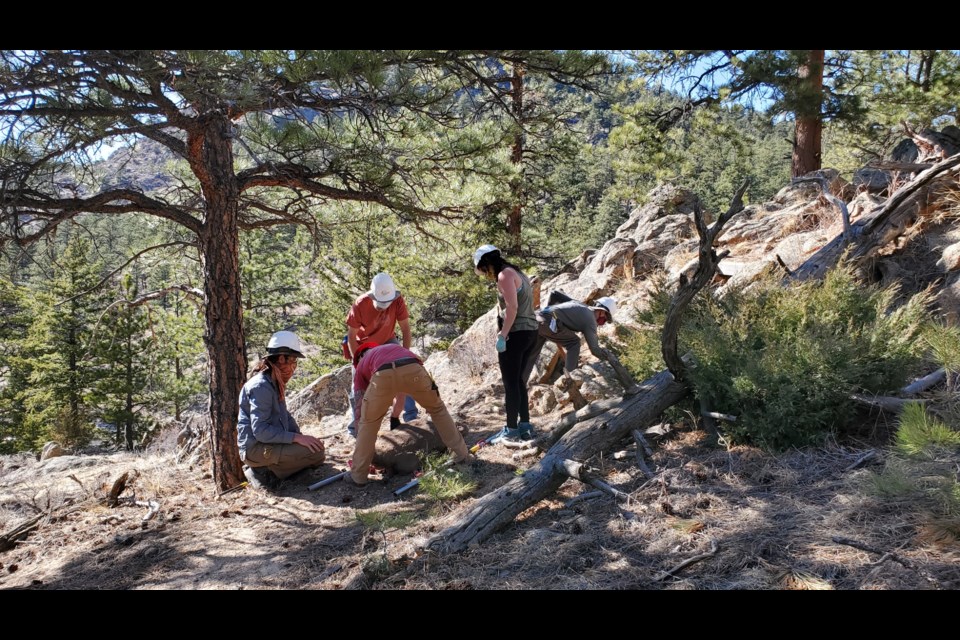Locals with a desire to get up close and personal with Longmont’s parks and open spaces have plenty of opportunities to get outside and also give back.
One day it could be pulling out invasive saplings or painting cottonwoods with sand to protect the bark, another could be watering trees. Just a day in the life of volunteers with Wildland Restoration Volunteers, or WLRV, and the city of Longmont’s Parks and Natural Resources department.
“We do all sorts of work all over the place, but we’re working in Longmont in a big way this year,” said WLRV Restoration and Invasive Species Program Manager Morgan Crowley. “We’ve done 18 or 20 projects in Longmont already this season and we have a handful more coming up.”
Part of WLRV’s focus on Longmont is in part due to relocating the headquarters to 21st Avenue and Collyer Street in 2019. Renovations took some time due to the pandemic and other infrastructure needs, but the nonprofit is settling in now and ready to go. The goal is to eventually turn the office into a community hub for environmental work in the future, according to Crowley.
Partnering with WLRV, the city of Longmont was awarded a grant from Great Outdoors Colorado to fund conservation and restoration projects in the area. WLRV has worked with Longmont for a number of years now, but being neighbors inspired the agency to step it up, according to Crowley. The grant will help with funding for projects through 2022.
The current event calendar for WLRV runs through mid-October with eight events. The next opportunity will be native seed collection at Button Rock Preserve on August 24. Volunteers will collect seeds from flowers and grasses, which will then be used by the city of Longmont for future restoration projects.
“We find that the best you can do is use the most local seed possible for restoration projects,” Crowley said. “If we’re going to do a restoration project in Button Rock, using seeds that were collected there will have the most competitive advantage over other seeds. Those will be the most likely to grow and compete with noxious weeds.”
According to Crowley, WLRV alternates weeks with their group of volunteers and crews from the city of Longmont to water native trees at McIntosh Lake. Removing Russian olive trees along the waterways throughout the city is another volunteer undertaking, to control one of the state-listed noxious weeds. There are two days on the calendar in September and October addressing the Russian olive trees.
One of the more unique and counterintuitive opportunities for habitat management is building barriers for prairie dogs at Blue Skies Park and Sandstone Ranch. In order to help Longmont’s prairie dog colonies coexist with multi-use parks, fences are erected to keep them from migrating where they shouldn’t.
Putting up fences may seem odd for managing burrowing critters, but there is a method to the madness. According to Taylor Gifford, volunteer coordinator for Longmont’s Parks and Natural Resources, prairie dogs prefer to keep the colony in sight. Putting up the barriers discourages expansion of colonies and helps keep prairie dogs contained, Gifford said.
“Theoretically, if you provide a visual barrier, prairie dogs won’t go somewhere. They’re short little guys, they stand up and look around to survey their territory,” Crowley said. “As long as they can’t see where they might go, they won’t go over there.”
Gifford worked with WLRV and Boulder in a similar role for several years before stepping into the newly minted full-time position with the city a month ago. The permanent volunteer coordinator position is part of the city’s dedication to conservation and restoration work for the green spaces, according to Gifford. COVID restrictions and budget restraints, along with an increase in outdoor recreation since the start of the pandemic, have taken a toll on the ability to tackle larger projects. Gifford hopes that bringing in more opportunities for residents will ease some of the burden on the ecosystem.
“This work is always important, but especially now there is a ton of work to do and a ton of opportunities to get outside and join us,” Gifford said.
There are park projects coming up with the city of Longmont, like mulching opportunities at Blue Skies Park. Gifford also highlighted a citizen science opportunity in partnership with Can’d Aid and other organizations, cataloging and identifying aquatic macroinvertebrate species along the St. Vrain Creek. Gifford also mentioned opportunities with trail maintenance at Button Rock Preserve, though dates haven’t been set yet.
WLRV also works frequently with Boulder County and other agencies across the state. Its volunteers have been helping with mulching efforts at Heil Valley Ranch Open Space, part of the CalWood fire recovery.
Crowley has noticed an uptick in volunteers this season. When WLRV released the event schedule for the season in March, Crowley said most of the events posted had a waitlist within a week.
“I think this year it was a combination of people wanting to get involved with fire restoration, but also people rearing for social opportunities post-Covid,” Crowley said.
Volunteer opportunities at WLRV are open to anyone and locals looking to get more in depth can sign up for leadership opportunities as well. According to Crowley, WLRV events have some spaces reserved for Longmont’s volunteer team, so if an event is full there could be space on the city side. The city of Longmont maintains a calendar of events, as well as ongoing volunteer opportunities that range from raptor monitoring and adopt-a-park days to trash pick ups and more.



